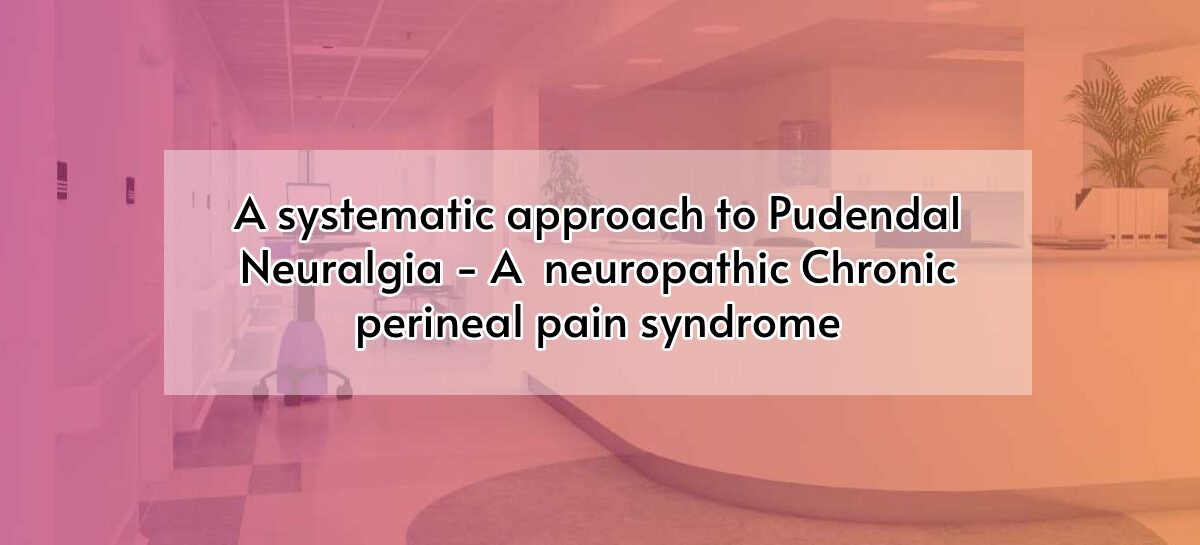Introduction
Chronic anal pain is difficult to diagnose and treat, especially with no obvious anorectal cause apparent on clinical examination. In chronic anal pain there are 3 main categories, those are localized causes, functional causes, and neuropathic pain. The most common category is local anorectal causes and includes a textbook list of anal conditions and chronicity of these conditions can also cause chronic anal pain. Neuropathic pain syndromes are rare but can be positively diagnosed to allow specific management. The diagnosis of pudendal neuralgia is primarily clinical and should be reviewed in the light of the course of the disease. Hence a thorough clinical knowledge and a systematic approach is essential.
Case history
A 17 yr boy who has been suffering from pain around the anus area for 2 years. Initially this pain was aggravated by prolonged sitting and standing ( chronicity) and relived by lying down. But, at time progresses the pain worsens during night time and also reproduced during micturition and defecation. Later on it radiating above upto sacral area , below inner thigh region upto mid thigh area.. It was a constant dull aching in nature initially and as the time progresses it disturbs even during night time too. The boy was initially treated as hamstring muscle strain and treated with stretches and strengthening exercises elsewhere. The pain was minimally controlled, but reproduced during sitting . Later patient was directed to do MRI ,it showed minor edema around second coccygeal bone. Then he was diagnosed as coccydynia and managed with neuropathic medicines and exercise and also advised to use donut pillow. Patient had some relief and managed the pain with all these measures. But the night pain was not subsided, hence he was instructed to do another MRI pelvis after 6 months . The second MRI seems to be absolutely normal.
Discussion
This boy was referred for pain management, initially he was suspected to have coccydynia and prescribed neuropathic medicines. The pain was not settled and moreover the pain radiating to inner thigh, further upto sacrum and worsens with urination lights the suspicion of Pudendal neuralgia . In Clinical examination he has been found to have left sided tenderness over the medial part of ischial tuberosity ( Tinel’s sign). With all these clinical material we narrowed down to our diagnosis. In next visit we did USG guided pudendal nerve block , which turn to be positive and he had good pain relief till date, which confirms the diagnosis of pudendal Neuralgia.
The Pudendal neuralgia refers to a chronic perineal pain syndrome due to entrapment between sacrotuberous and sacrospinous ligaments ,an entrapment neuropathy and this is diagnosed purely by clinical means only. The pain of pudendal neuralgia may be unilateral or bilateral and may radiate to the pelvis and thighs and cause deep pelvic discomfort. A burning sensation and numbness or paresthesia in the gluteal, perineal, and genital areas are commonly reported in association with the pain. Patients with pudendal neuralgia often suffer for several years before being diagnosed. Like any other Neuropathic pain the earlier the diagnosis lights the way for easy management strategies.
Four domains of diagnosis ,Nantes criteria have been defined, namely: (A) essential criteria, (B) complementary diagnostic criteria, (C) exclusion criteria, (D) associated signs not excluding the diagnosis. Pain should be relieved by anesthetic infiltration of the pudendal nerve. This is an essential criterion, but poorly specific.
Pitfalls like localized causes may lead to a nonselective approach to diagnosis and to an extensive workup including endoscopy, anorectal physiologic testing, endoanal ultrasonography, or pelvic magnetic resonance imaging (MRI), with the goal of excluding other diagnoses. Thus, a selective approach is generally recommended based on suspicion from the patient’s history and examination findings of past or present structural disease.
Conclusion
The key to diagnosis of chronic anal pain is to first exclude specific diseases and then to make a positive diagnosis, which will guide management. The clinicians who armed with a relatively basic knowledge of possible diagnosis and treatments for chronic anal pain can make a specific diagnosis and initiate treatment even without a complex evaluation. The diagnosis of pudendal neuralgia is primarily clinical and should be reviewed in the light of the course of the disease. However once it diagnosed the pudendal neuralgia is treated by pudendal nerve block that is both diagnostic and therapeutically.
References
1.Chronic anal pain: A review of causes, diagnosis, and treatment Charles H. Knowles, PhD, FRCS, FACCRS (Hons) and Richard C. Cohen, MD, FRCS Cleveland Clinic Journal of Medicine June 2022, 89 (6) 336-343; DOI:
2.Pudendal Neuralgia -Rana AL-Jumah MD, Krishna B. Shah MD, in Interventional Management of Chronic Visceral Pain Syndromes, 2021
3.Anorectal pain -Giuseppe Chiarioni, Stefan-Lucian Popa, in Clinical and Basic Neurogastroenterology and Motility, 2020
 V.Karthickraja MD,DA,FIPM
V.Karthickraja MD,DA,FIPM
Consultant Anesthesiologist and Pain physician
Kauvery hospital, Chennai



